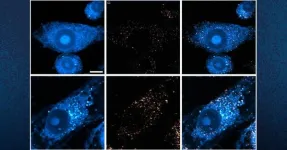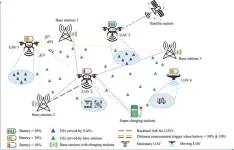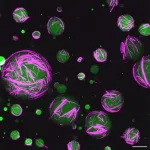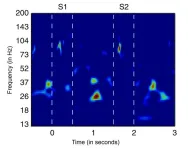(Press-News.org) Alzheimer’s disease causes significant problems with memory, thinking and behavior and is the most common form of dementia, affecting more than 50 million people around the world each year. This number is expected to triple by the year 2050.
Using their own state-of-the art imaging technologies, scientists at the University of California San Diego have now revealed how the metabolism of lipids, a class of molecule that includes fats, oils and many hormones, is changed in Alzheimer’s disease. They also revealed a new strategy to target this metabolic system with new and existing drugs. The findings are published in Cell Metabolism.
“Lipids have been associated with Alzheimer’s for as long as we’ve known about the disease,” said senior and co-corresponding author Xu Chen, Ph.D., an assistant professor in the Department of Neurosciences at UC San Diego School of Medicine, referring to the original 1907 report by Alois Alzheimer that described the unusual presence of fat deposits in the brain of the first person to be diagnosed with the disease. “So much of the emphasis since then has been placed on tau and other proteins that the research community has, until the last decade or so, largely overlooked this important aspect of the disease.”
“Driven by a keen interest in lipid droplet functions in aging and disease, we initiated this fruitful collaboration to harness cutting-edge SRS technology for studying lipid metabolism in tauopathy mouse brains.” Said Yajuan Li, M.D., Ph.D., a postdoctoral researcher in the Shu Chien-Gene Lay Department of Bioengineering at UC San Diego Jacobs School of Engineering. SRS imaging is an approach that analyzes the way molecules in a sample interact with laser light.
In the brain, lipids come in the form of tiny droplets that control a variety of processes, such as energy storage and cellular responses to stress. These processes are tightly regulated in typical brains, but in Alzheimer’s or similar diseases, lipid droplet metabolism can malfunction. While scientists understand that there is a relationship between Alzheimer’s and lipid metabolism, exactly how they influence one another has remained a mystery.
To answer this question, the team looked directly at lipid droplets in the brains of mice with excess tau protein. They used a state-of-the-art SRS imaging platform developed in Lingyan Shi’s lab at the Jacobs School of Engineering. The platform makes it possible to take microscopic images of lipid droplets within cells without the use chemical dyes, which can alter the delicate molecules and compromise the results.
“Intriguingly, the inert lipid droplets observed in tauopathy brains exhibit similar behavior to those found in aging brains”, said co-corresponding author Lingyan Shi, Ph.D., assistant professor of bioengineering at the Jacobs School. “We are now focusing on understanding the underlying mechanisms by combing SRS imaging with other utilizing multidisciplinary techniques. Our approach is biologically neutral, so we’re able to observe what’s happening in the brain at the molecular level with as little interference as possible.”
Shi and her team, including Li, pioneered the new approach, which uses a specially modified version of water, called heavy water, as a metabolic probe.
“Instead of using a typical chemical dye to stain lipids, we use heavy water that is naturally participating in the metabolic activities we’re interested in,” added Shi. “This gives us a much clearer picture of how lipids are formed spatiotemporally, which would not be possible with other approaches. Our current focus is on comprehending the underlying mechanisms of these dynamic changes of lipid metabolism in the context of aging and diseases.”
The researchers discovered that in brains with tauopathy, neurons accumulate excess lipids as a result of stress or damage. This influx forces neurons to offload the excess to immune cells in the brain, called microglia. These microglia then mount an inflammatory response that causes further stress to neurons, triggering a repeating and worsening cycle.
In addition to characterizing this process, they were also able to identify a critical enzyme, called adenosine monophosphate-activated protein kinase (AMPK) that orchestrates the cycle. According to the researchers, breaking this cycle could unlock new treatment options for Alzheimer’s disease. Chen is particularly optimistic about the possibility of repurposing existing drugs that modify lipid metabolism.
“We don’t think this is an incidental phenomenon,” said Chen. “The evidence suggests that lipid metabolism is a driving mechanism for Alzheimer’s disease. There are many drugs that target lipid metabolism in other body systems, such as in the liver, so we might be able to change this system quite dramatically using tools we already have.”
Link to full study: https://doi.org/10.1016/j.cmet.2024.03.014
Additional co-authors on the study include Daniel Munoz-Mayorga, Yuhang Nie, Ningxin Kang, Yuren Tao, Jessica Lagerwall, Carla Pernaci, Genevieve Curtin, Nicole G. Coufal and Jerome Mertens, all at UC San Diego.
This work was funded, in part, by the National Institutes of Health (grants R01AG074273, R01AG078185, 1R01GM149976-01, R01NS111039 R21NS125395) and by the startup fund from UC San Diego Department of Neurosciences and Jacob School of Engineering.
# # #
END
Innovative microscopy demystifies metabolism of Alzheimer’s
Researchers at UC San Diego have deployed state-of-the art imaging techniques to discover the metabolism driving Alzheimer’s disease; results suggest new treatment strategies
2024-04-23
ELSE PRESS RELEASES FROM THIS DATE:
Toward unification of turbulence framework – weak-to-strong transition discovered in turbulence
2024-04-23
Turbulence is ubiquitous in nature. It exists everywhere, from our daily lives to the distant universe, while being labelled as “the last great unsolved problem of classical physics” by Richard Feynman. Prof. Dr. Huirong Yan and her group from the Institute of Physics and Astronomy at the University of Potsdam and DESY have now discovered a long-predicted phenomenon: the weak-to-strong transition in small amplitude space plasma turbulence. The discovery was made by analyzing data from ESA’s Cluster mission – a constellation of four spacecraft flying in formation around Earth and investigating how the Sun and the Earth interact.
The ...
Innovative GREENSKY model elevates UAV efficiency in next-gen wireless networks
2024-04-23
Researchers from the University of Missouri-Kansas City, School of Computing and Engineering, and independent researchers have developed a groundbreaking model, dubbed GREENSKY, that significantly enhances the energy efficiency and operational time of Unmanned Aerial Vehicles (UAVs) in cellular networks.
In the ever-evolving landscape of wireless communication, UAVs play a pivotal role, especially in rural, remote, and disaster-struck areas where traditional network infrastructure is absent. ...
Majority of acute care hospitals do not admit representative proportion of Black Medicare patients in their local market
2024-04-23
A study analyzing a large sample of Medicare admissions at nearly 2,000 acute care hospitals nationwide during 2019 found that most hospitals—nearly four out of five—admitted a significantly different proportion of Black fee-for-service Medicare patients age 65 and older compared to the proportion of the same group of patients admitted to any hospital in that hospital’s market area.
The researchers say that understanding hospital choices within neighborhoods and markets could ...
Smoking cessation before laryngeal cancer treatment improves survival, retention of voice box, study shows
2024-04-23
In a study of patients who smoked when they were diagnosed with laryngeal cancer, those who quit smoking before starting chemotherapy or radiation responded better to treatment, were less likely to need their voice boxes surgically removed, and lived significantly longer than those who continued to smoke. The research, from the University of Oklahoma, is published in the journal Otolaryngology-Head and Neck Surgery.
The study’s lead author, Lurdes Queimado, M.D., Ph.D., said the findings underscore the importance of integrating tobacco cessation programs into treatment plans for cancer of the larynx, an area of the throat involved in breathing, swallowing ...
Major milestone reached for key weapons component
2024-04-23
ALBUQUERQUE, N.M. — Sandia National Laboratories and the Kansas City National Security Campus completed a crucial weapons component development milestone, prior to full rate production.
The Mark 21 Replacement Fuze interfaces with the W87-0 warhead for deployment onto the Minuteman III and, eventually, the Sentinel Intercontinental Ballistic Missile.
The first production unit of the replacement fuze was approved through the National Nuclear Security Administration’s rigorous Quality Assurance Inspection Procedure ...
PCORI announces $150 million in funding for new health research
2024-04-23
WASHINGTON, D.C. – The Patient-Centered Outcomes Research Institute (PCORI) today announced the approval of funding awards totaling more than $150 million to support new patient-centered comparative clinical effectiveness research (CER) studies, research to strengthen the rigor and quality of patient-centered CER and a project to implement the findings of PCORI-funded research into practice.
Among the nine awards for patient-centered CER, two include support for large, two-phased trials comparing approaches to treatments for heart failure and asthma. Two other large studies will compare health system strategies to improve hypertension control, and another will evaluate ...
Infected: understanding the spread of behavior
2024-04-23
Human beings are likely to adopt the thoughts, beliefs, and behaviors of those around them.
Simple decisions like what local store is best to shop at to more complex ones like vaccinating a child are influenced by these behavior patterns and social discourse.
“We choose to be in networks, both offline and online, that are compatible with our own thinking,” explained Amin Rahimian, assistant professor of industrial engineering at the University of Pittsburgh Swanson School of Engineering. “The social contagion of behavior through networks can help ...
UNC-Chapel Hill researchers create artificial cells that act like living cells
2024-04-23
In a new study published in Nature Chemistry, UNC-Chapel Hill researcher Ronit Freeman and her colleagues describe the steps they took to manipulate DNA and proteins — essential building blocks of life — to create cells that look and act like cells from the body. This accomplishment, a first in the field, has implications for efforts in regenerative medicine, drug delivery systems, and diagnostic tools.
“With this discovery, we can think of engineering fabrics or tissues that can be sensitive to changes in their environment and behave in dynamic ways,” says Freeman, whose lab is in the Applied Physical Sciences Department of the UNC College ...
New research develops forest extent map for Mexico
2024-04-23
To properly protect forests and evaluate the state of natural resources, conservation practices and environmental policies, it is important to have accurate information on an area’s forest extent. One of the challenges facing researchers when it comes to evaluating the accuracy of forest extent, however, is that models use different remote sensing products that may have different definitions for what determines forest extent. In addition, on the ground surveys may sometimes come into conflict with what remote, satellite-based products are describing as forests.
To help quantify this problem, a group of researchers from ...
In the brain, bursts of beta rhythms implement cognitive control
2024-04-23
The brain processes information on many scales. Individual cells electrochemically transmit signals in circuits but at the large scale required to produce cognition, millions of cells act in concert, driven by rhythmic signals at varying frequencies. Studying one frequency range in particular, beta rhythms between about 14-30 Hz, holds the key to understanding how the brain controls cognitive processes—or loses control in some disorders—a team of neuroscientists argues in a new review article.
Drawing on experimental ...
LAST 30 PRESS RELEASES:
Numbers in our sights affect how we perceive space
SIMJ announces global collaborative book project in commemoration of its 75th anniversary
Air pollution exposure and birth weight
Obstructive sleep apnea risk and mental health conditions among older adults
How talking slows eye movements behind the wheel
The Ceramic Society of Japan’s Oxoate Ceramics Research Association launches new international book project
Heart-brain connection: international study reveals the role of the vagus nerve in keeping the heart young
Researchers identify Rb1 as a predictive biomarker for a new therapeutic strategy in some breast cancers
Survey reveals ethical gaps slowing AI adoption in pediatric surgery
Stimulant ADHD medications work differently than thought
AI overestimates how smart people are, according to HSE economists
HSE researchers create genome-wide map of quadruplexes
Scientists boost cell "powerhouses" to burn more calories
Automatic label checking: The missing step in making reliable medical AI
Low daily alcohol intake linked to 50% heightened mouth cancer risk in India
American Meteorological Society announces Rick Spinrad as 2026 President-Elect
Biomass-based carbon capture spotlighted in newly released global climate webinar recording
Illuminating invisible nano pollutants: advanced bioimaging tracks the full journey of emerging nanoscale contaminants in living systems
How does age affect recovery from spinal cord injury?
Novel AI tool offers prognosis for patients with head and neck cancer
Fathers’ microplastic exposure tied to their children’s metabolic problems
Research validates laboratory model for studying high-grade serous ovarian cancer
SIR 2026 delivers transformative breakthroughs in minimally invasive medicine to improve patient care
Stem Cell Reports most downloaded papers of 2025 highlight the breadth and impact of stem cell research
Oxford-led study estimates NHS spends around 3% of its primary and secondary care budget on the health impacts of heat and cold in England
A researcher’s long quest leads to a smart composite breakthrough
Urban wild bees act as “microbial sensors” of city health.
New study finds where you live affects recovery after a hip fracture
Forecasting the impact of fully automated vehicle adoption on US road traffic injuries
Alcohol-related hospitalizations from 2016 to 2022
[Press-News.org] Innovative microscopy demystifies metabolism of Alzheimer’sResearchers at UC San Diego have deployed state-of-the art imaging techniques to discover the metabolism driving Alzheimer’s disease; results suggest new treatment strategies







